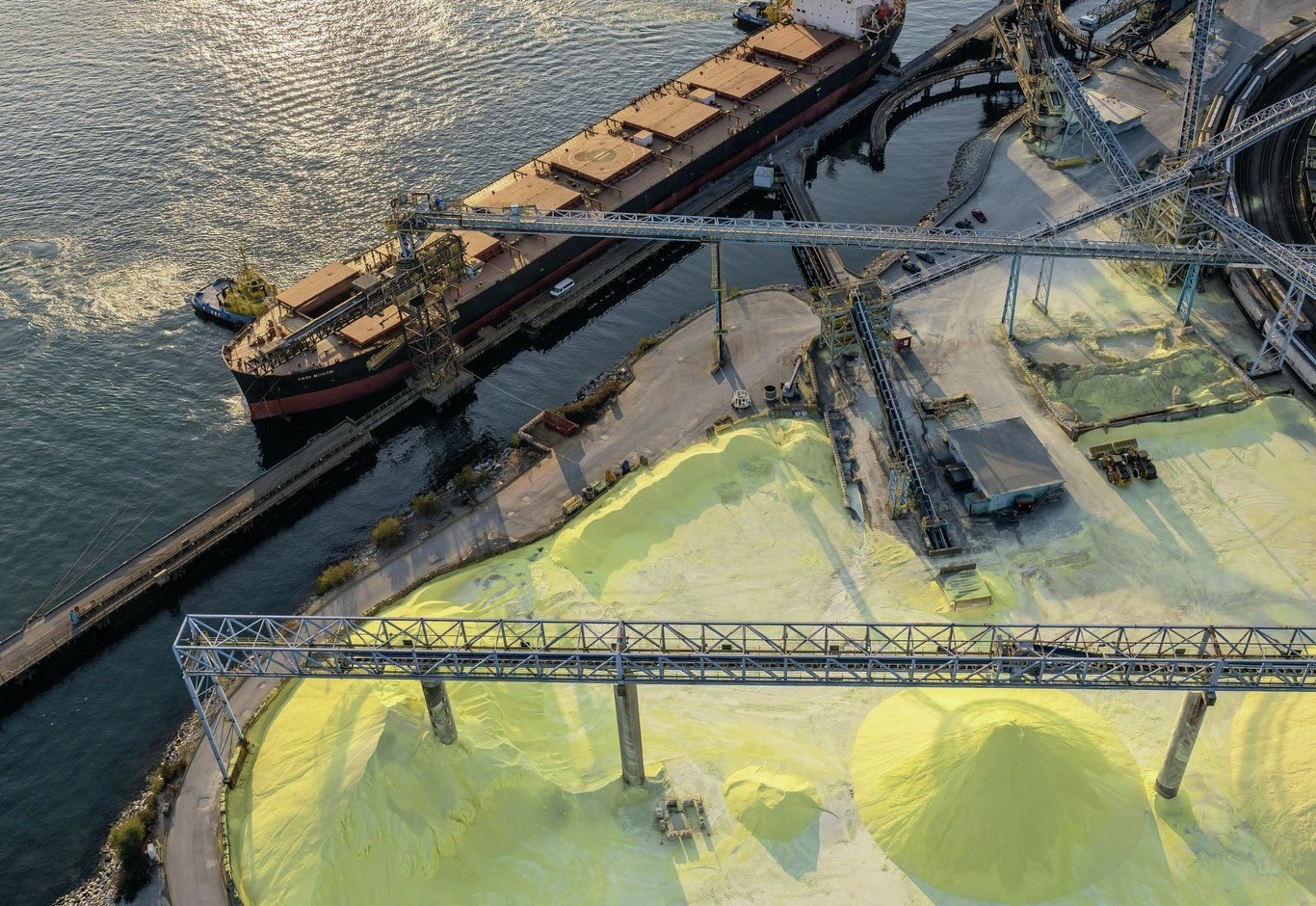Sulphur 420 Sep-Oct 2025

18 September 2025
North America’s sulphur industry
NORTH AMERICA
North America’s sulphur industry
Sulphur output in North America continues to decline due to refinery closures and conversions at the same time that acid demand is increasing for metals processing projects.

While Canada continues to be a major exporter of sulphur, declining refinery output in the US and falling sour gas production in North America at the same time as new copper and nickel projects come onstream in the US means that the US is likely to become a net sulphur importer over the next few years.
Sulphur production – refining
Thanks to the shale oil boom, the US remains far and away the world’s largest oil producer, with an output of over 19 million bbl/d in 2023. It is also the world’s largest consumer, and still just about a net importer. Refinery throughputs are also at high levels, although in spite of a couple of boom years in 2022 and 2023, marked by record refining margins and profits, the North American refining industry had to face significant challenges in 2024, including sluggish demand for traditional fuels, especially in North America and Europe, and tightening profit margins due to increased global supply and lower demand growth. Other continuing issues include higher operating costs, ageing infrastructure, strict environmental regulations, and a shortage of skilled labour.
At the start of the year, the US Energy Information Administration (EIA) reported that total US refining capacity totalled 18.4 million bbl/d, the same as for the previous year. However, capacity is set to drop by 3% over the course of 2025, the EIA says, with LyondellBasell’s Houston oil refinery closing, and the Los Angeles refinery of Phillips 66 scheduled for closure by the end of 2025. More closures are scheduled for the next couple of years, especially in California, where Phillips 66 announced plans last October to close its 139,000 bbl/d Wilmington refinery in the Los Angeles area, and Valero said it would end refining operations at its 145,000 bbl/d Benicia refinery in the Bay Area by the end of April 2026. Other refineries are converting to bio-feeds or other sustainable production.
California is leading this shift, in part due to the state’s low carbon fuel mandate. At least three of the state’s 11 refineries; Phillips 66 in Rodeo, Marathon in Martinez and another refinery in Bakersfield – have completed conversions, or have announced plans to convert, to renewable diesel fuel production since 2022. While sulphur output from US refineries is expected to decline due to these closures and conversions, another factor has been the disruption in oil supply from Russia due to economic sanctions. US refiners are using more domestic crude, which is often from tight oil fracking and fairly sweet compared to the heavier, sourer feeds from Russia. Overall sulphur content of crude processed in the US has been trending downward since 2018, decreasing from an average of 1.39% to 1.30% in Q1 2025.
US refinery sulphur output is concentrated in the Gulf Coast region (PADD 3), where 60% of sulphur recovery capacity is located. PADD 2 is next, with 20% of capacity, and PADD 5 with 14%. The other two regions each have only about 2.5% each. US refinery sulphur output was about 7.57 million t/a in 2024, but CRU expects this to have fallen to 7.24 million t/a by 2029.
The story is different north of the border in Canada, which continues to be the world’s fourth largest oil producer, though it exports more than half of this, much of it to the US. Canadian crude production continues to rise, split roughly 2:1 between oil sands bitumen and conventional oil production. Oil sands output continues to rise, reaching 3.3 million bbl/d in 2024, and expected to rise by another 5% to reach 3.5 million bbl/d in 2025. As oil sands are sulphur-rich (about 4-5% by weight), where this production is processed is of vital importance to the sulphur industry.
Downstream, Canada’s domestic refining capacity is relatively small; there are 17 refineries operational in Canada (including two bitumen refineries), 1.93 million barrels per day. Refinery capacity is concentrated in the east of the country, especially Ontario, Quebec and the Atlantic coast (Labrador, Newfoundland, New Brunswick). These provinces between them operate 1.24 million bbl/d of capacity, or about two thirds of the total. In Alberta, meanwhile, much of the refinery capacity is geared at processing oil sands crude. Oil sands processing now accounts for the majority of Canada’s sulphur output, standing at just under 3 million t/a in 2024, as shown in Table 1. This figure is likely to stay roughly the same out to 2029, with any increased production likely to be exported rather than processed domestically.
Sulphur production – Sour gas
The other significant source of elemental sulphur in North America comes from sour gas processing. US sour gas processing is largely from mature field on the west coast and northern Rocky Mountains area, and has also been undercut by cheaper fracked gas. US sour gas production has fallen by half in the past decade, though there may be some slight recovery towards the end of the decade, with sulphur output forecast to rise slightly from 420,000 t/a to 490,000 t/a.
It is a similar story in Canada, with sour gas wells declining and most new production coming from unconventional (shale gas) production. In spite of some new production from British Columbia, Canadian sour gas production continues to be on a long slow decline, with sulphur output falling from 1.62 million t/a to 1.54 million t/a out to 2029.
Sulphur demand – phosphates
The US phosphate industry has traditionally been the largest consumer of sulphur in North America, to make sulphuric acid for phosphate extraction. North American production of phosphoric acid in 2024 was 5.5 million tonnes P2O5. US downstream phosphate production is mainly aimed at mono- and diammonium phosphate, accounting for 2.0 million t/a P2O5 and 0.7 million t/a P2O5, respectively. Growth in production of cheap finished phosphates elsewhere in the world, such as Saudi Arabia and Morocco, is affecting the North American market, combined with depleting resources at phosphate mines. The fall has seen considerable industry rationalisation and consolidation, with only four producers now still active. US sulphur demand for phosphate production in 2024 dropped by 1.2 million t/a as the US faced production outages in the phosphate sector. Imports mirrored the demand trend, with sulphur purchases dropping to 1.3 million t/a.
Canada has no phosphate capacity at present, though Ariane Phosphates has made considerable progress with developing the Lac a Paul resource in Quebec and has plans for downstream purified phosphoric acid capacity of around 350,000 t/a of battery/food grade PPA, as well as 220,000 t/a of lower grade acid used in animal feeds and speciality fertilizers. There is as yet no firm timescale on this project, however.
Sulphuric acid
In addition to the elemental sulphur, sulphuric acid is also produced from smelting operations within the US and Canada. This is mostly from copper smelting, though there is also some recovery from zinc and molybdenum operations. Acid production was 2.2 million t/a in the US in 2024, and 2.1 million t/a in Canada.
Sulphur demand – metals
Outside of the phosphate industry, there is sulphur demand to manufacture sulphuric acid for metal leaching and other industrial processes, including caprolactam, pulp and paper processing, and especially sulphuric acid use as an alkylation agent in refining – a field in which the US refining industry has been a pioneer. There is also around 2 million t/a of demand from copper leaching projects, mainly in the southwest of the US.
In the short term, additional demand is expected to come from new copper leaching projects, with Florence Copper saying that construction is 90% complete at its operations in Arizona, and targeting first copper recovered by the end of the year, and Excelsior beginning SX/EW operations at Gunnison in August this year. Freeport is also moving ahead with operations at Morenci to recover copper from mine tailings.
Looking ahead to 2028, there are also several lithium projects for battery production, mostly in Nevada and Utah, which could add considerable additional demand for acid. Ioneer and Lithium Americas both have sulphur burning acid plants as part of their operation, and are expected to add 560,000 t/a of demand for sulphur by 2029. Overall US demand for sulphuric acid is expected to rise from 28.3 million t/a in 2024 to 32.1 million t/a in 2029.
Sulphur trade
Lack of domestic demand means that Canada operates a significant sulphur surplus, and while it is no longer the largest sulphur exporter in the world, it is still the fourth largest exporter, with around 3.7 million tonnes exported in 2024. About 830,000 tonnes of this was exported south to the US, mainly as molten sulphur. Sulphur remains not subject to US tariffs for now. Some of this export volume has come from stock drawdowns from sour gas producers. Over the next four years, Canadian sulphur exports are expected to remain at a level between 3.7 and 4.2 million t/a, depending on stock build/drawdown requirements. The stock drawdown will be crucial to maintaining export volumes due to the expected decline from sour gas-based supply towards the end of the period. Reducing molten volumes travelling south to Canada has meant that Canada has had to invest in domestic forming capacity, such as Heartland Sulphur near Edmonton, Alberta.

US sulphur consumption is expected to recover this year, and as sulphur consumption increases over the coming years, it is unlikely that supply will keep up with consumption, leading import requirements to increase from 2025 to 1.9 million t/a. As local availability falls, increased import requirements will be necessary to support future demand. US sulphur exports are also expected to fall.





